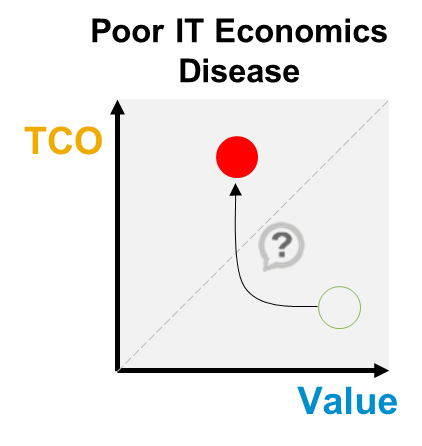
- SAP Community
- Products and Technology
- Technology
- Technology Blogs by SAP
- 10 Root Causes For Diseased IT Economics
- Subscribe to RSS Feed
- Mark as New
- Mark as Read
- Bookmark
- Subscribe
- Printer Friendly Page
- Report Inappropriate Content

For years we are reducing TCO and increasing IT enabled business value. And in fact, there are so manifold measures, best practices, methods, tools, technologies and solutions to improve IT effeciency as well as to deliver more value to the business available. And most companies and IT departments leverage these to a large extent.
 So, my question is: Why does the "Poor IT Economics Disease" always come back?
So, my question is: Why does the "Poor IT Economics Disease" always come back?
Here are 10 root causes I found:
1. High business dynamics combined with limited flexibility of IT resources and cost
2. Fast, anorganic growth (i.e. mergers & acquisitions)
3. Insufficient understanding between business and IT
4. Lack of an IT strategy and missing architecture management
5. Bad prioritization and selection of (IT) projects
6. High degree of individualization (regarding business processes and IT solutions)
7. Bad project execution
8. Quick & Dirty (Interims-) solutions - which remain
9. Decentral organizational structures without central governance combined with political decisions
10. Lack of competencies/ skills (e.g. to manage exteral provider, to manage new technologies)
My advice:
- Recognize pattern and identify root causes for the "Poor IT Economics Disease" in your IT organization (beyond solving incidents and problems)
- Analyze your (IT) project portfolio: Which projects/ actions cure symptoms of the disease? Which projects/ actions solve or manage the root cause?
- Build up a strategic masterplan which helps to manage root causes you cannot influence and eliminate root causes you can control
- Leverage Design Thinking to uncover and solve rood causes
Check this interesting blog: Inefficiencies in your IT Operations? SAP can help you with Design Thinking!
Your view matters: What is your perspective regarding these root causes? What other root causes you see?
I would like to know your thoughts.
More information:
Check my blog about TCO Benchmarking: Control your IT Cost & identify Improvement Opportunities with TCO Benchmarking;
Follow me on Twitter @SAPSpotlight or connect to LinkedIn
- SAP Managed Tags:
- SAP NetWeaver Enterprise Search
You must be a registered user to add a comment. If you've already registered, sign in. Otherwise, register and sign in.
-
ABAP CDS Views - CDC (Change Data Capture)
2 -
AI
1 -
Analyze Workload Data
1 -
BTP
1 -
Business and IT Integration
2 -
Business application stu
1 -
Business Technology Platform
1 -
Business Trends
1,661 -
Business Trends
88 -
CAP
1 -
cf
1 -
Cloud Foundry
1 -
Confluent
1 -
Customer COE Basics and Fundamentals
1 -
Customer COE Latest and Greatest
3 -
Customer Data Browser app
1 -
Data Analysis Tool
1 -
data migration
1 -
data transfer
1 -
Datasphere
2 -
Event Information
1,400 -
Event Information
65 -
Expert
1 -
Expert Insights
178 -
Expert Insights
280 -
General
1 -
Google cloud
1 -
Google Next'24
1 -
Kafka
1 -
Life at SAP
784 -
Life at SAP
11 -
Migrate your Data App
1 -
MTA
1 -
Network Performance Analysis
1 -
NodeJS
1 -
PDF
1 -
POC
1 -
Product Updates
4,577 -
Product Updates
330 -
Replication Flow
1 -
RisewithSAP
1 -
SAP BTP
1 -
SAP BTP Cloud Foundry
1 -
SAP Cloud ALM
1 -
SAP Cloud Application Programming Model
1 -
SAP Datasphere
2 -
SAP S4HANA Cloud
1 -
SAP S4HANA Migration Cockpit
1 -
Technology Updates
6,886 -
Technology Updates
408 -
Workload Fluctuations
1
- 10+ ways to reshape your SAP landscape with SAP Business Technology Platform – Blog Series in Technology Blogs by SAP
- 10+ ways to reshape your SAP landscape with SAP Business Technology Platform – Blog 1 in Technology Blogs by SAP
- AN INTRODUCTION TO QUADRATIC UNCONSTRAINED BINARY OPTIMIZATION (QUBO) in Technology Blogs by SAP
- What's New with SAP BTP - Quarterly Live Series in Technology Blogs by SAP
- Getting Data From FreeHandSQL to Business Objects WebIntelligence in Technology Q&A
| User | Count |
|---|---|
| 13 | |
| 10 | |
| 10 | |
| 7 | |
| 6 | |
| 5 | |
| 5 | |
| 5 | |
| 4 | |
| 4 |